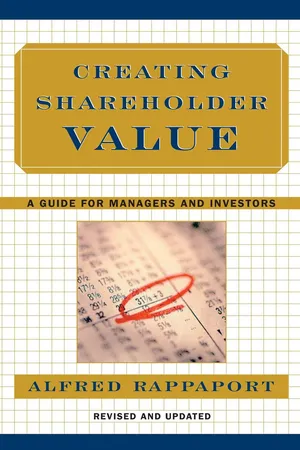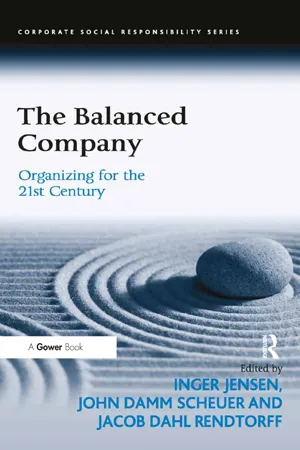Business
Maximizing shareholder value
Maximizing shareholder value refers to the goal of increasing the wealth of a company's shareholders through strategic decision-making and operational efficiency. This involves prioritizing actions that enhance profitability, increase stock price, and generate higher returns for investors. Companies often focus on maximizing shareholder value to attract and retain investment, ultimately driving long-term growth and success.
Written by Perlego with AI-assistance
Related key terms
5 Key excerpts on "Maximizing shareholder value"
- eBook - ePub
Financialization
Economic and Social Impacts
- Malcolm Sawyer(Author)
- 2022(Publication Date)
- Agenda Publishing(Publisher)
Jack Welch, former CEO of General Electric, argued that “shareholder value is the dumbest idea in the world. Shareholder value is a result, not a strategy … your main constituencies are your employees, your customers and your products. Managers and investors should not set share price increases as their overarching goal. … Short-term profits should be allied with an increase in the long-term value of a company” (interview with Francesco Guerrera, Financial Times, 12 March 2009). Stout (2012) seeks to debunk “the myth that corporate law mandates shareholder primacy”. The effects of the pursuit of shareholder value is that managers are seen as focusing myopically on short-term earnings, which discourages investment and innovation, and she argues that harms employees, customers and communities. The advocacy of the pursuit of shareholder value is a route through which shareholder interests are imposed on managerial interests. It also acts in the interests of the financial sector, which gains from increasing stock market valuations. Lazonick and O’Sullivan (2000) provide an historical account for the USA of the rise of shareholder value as the guiding principle of corporate governance, with a shift of corporate strategy from focus on retention of corporate profits and their reinvestment in corporate growth in the 1960s and 1970s to a strategy of distribution of profits to shareholders with pressures for reduction of labour employment. This leads to the other major issues arising from the pursuit of shareholder value, namely the impacts on the other stakeholders in a corporation - eBook - ePub
Shareholder Participation and the Corporation
A Fresh Inter-Disciplinary Approach in Happiness
- James McConvill(Author)
- 2020(Publication Date)
- Routledge-Cavendish(Publisher)
accommodative approach in which the interests of a broad range of stakeholders are considered. He wrote as follows:I don’t believe that there is any inconsistency between pursuing shareholder interests and ensuring that the interests of other stakeholders (employees, customers, communities, etc) are also met, if not exceeded.... No business will be able to sustain growth in shareholder value without first ensuring that employee morale and commitment is high. Equally, no company operating in a competitive arena can grow shareholder value without ensuring customer satisfaction is high.167Healy goes on to quote from Collins and Parras who state that thinking beyond the so-called ‘traditional’ realm of what is in the short-term economic interests of shareholders is also justified when considering the historical meaning of ‘shareholder primacy’. Hence, structuring internal corporate governance arrangements and enacting corporate law rules with a view to maximising shareholder happiness may be a very natural, and indeed long overdue, reformulation of the shareholder primacy norm.Contrary to business school doctrine, ‘maximising shareholder wealth’ or ‘profit maximisation’ has not been the dominant driving force or primary objective through the history of visionary companies. Visionary companies pursue a cluster of objectives, of which making money is only one — and not necessarily the primary one. Yes, they seek profits, but they’re equally guided by a core ideology — core values and sense of purpose beyond just making money. Yet, paradoxically, the visionary companies make more money than the more purely profit-driven comparison companies.168Finally, I submit, there is no contradiction in the view of the corporation both as an entity that is owned by shareholders due to characterising shares as property, and as an institution that must accommodate the interests of a broad range of stakeholders. Property as a concept is capable of, and indeed characteristically does, accommodate a range of different concerns and issues rather than being strictly an economic tool. Reference is made by Greenfield to a number of judicial decisions where the concept of ‘property’ was given this meaning. Accordingly, if the corporation were to embrace not-strictly-economic issues, with a greater orientation on shareholder happiness, the status of the shares as property owned by the shareholders would not be undermined. According to Greenfield: - eBook - ePub
The Boardroom
A Guide to Effective Leadership and Good Corporate Governance in Southeast Asia
- Peter Verhezen, Tanri Abeng(Authors)
- 2022(Publication Date)
- De Gruyter(Publisher)
shared value creation. Companies must earn a profit, but it is also true that only those organizations that make some contribution to society – and not demolish it in one form or another – will survive. Ultimately, society and its judicial system only permits companies who contribute to society. Companies create value and benefits for customers, employees, and their partners – be it suppliers or distributors. The company will capture some of that value where profit becomes a result of and not the ultimate objective of good and effective business leadership.We finally may move from a paradigm of profitability maximization to optimizing and sharing created value. Profit maximization has been the prevailing adage of most boards and business schools training those potential future members. Today, creating shared or sustainable value is now more and more acknowledged. Stakeholders’ benefits have become part of business attention, and the organization’s wising up act16 may result in sharing some of the economic value that is created, making the organization [more] acceptable by society and, therefore, sustain its economic sustainability.Paradoxically, optimizing economic value may not be a mathematical one-dimensional maximization challenge, but usually involves harmonizing and balancing the interests of a number of engaged stakeholders. Even opposing interests are not necessarily a choice between either. Paradoxal leadership can turn the “Power of And”17 into motion. It would mean that such an exercise attempts to reconcile purpose and values with the major objective of making money and profit. Strategic thinker and philosopher Darden Business School Professor Ed Freeman is a staunch believer that taking the stakes of those involved in the organization seriously can release an unbound energy that enhances the traditional organizational flywheel focus on profitability. “Stake-brokers” are highly engaged and informed individuals who strongly believe that organizations need to “build skills of relationship repair and resilience18 ”. A creating-value-for-stakeholders mindset19 transcends the potential conflict between the different stakeholders. One could easily argue that in the long term, it is impossible to optimize profitability by emphasizing just the providers of capital and ignoring all the others. Serving all stakeholder groups in one way or another – and not necessarily with equal weight – requires a committed form of paradoxal leadership. The board is charged with serving the best interests of the corporation and its shareholders – including long-term shareholders, diversified shareholders and pro-social and pro-ecological shareholders. All depends on how we define shareholders: expanding our understanding of the nature of ‘the shareholder’ would benefit both legitimate investors20 - eBook - ePub
Creating Shareholder Value
A Guide For Managers And Investors
- Alfred Rappaport(Author)
- 1999(Publication Date)
- Free Press(Publisher)
The commitment to devote substantial organizational resources should be preceded by a confident understanding of shareholder value implementation objectives and expected outcomes. Understanding how a shareholder value focus is likely to transform the organization serves not only as an initial road map, but as positive motivation to reap the rewards of successfully implementing change. A successful implementation means that management and the remainder of the organization have embraced the following shareholder value principles:- Value is driven by long-term, risk-adjusted cash flow performance, not short-term earnings.
- Not all growth is value-creating.
- “Value-creating projects” embedded in value-destroying strategies are poor investments.
- Value alternative strategies and select strategy with the maximum expected shareholder value added (SVA).
- Find the highest valued use for all assets.
- Base performance evaluation and incentive compensation on shareholder value added (SVA) and other indicators of long-term value.
- Return cash to shareholders when value-creating investments are not available.
Figure 9-1 depicts the shareholder value management cycle when the foregoing principles are established in an organization.Shareholder value typically is implemented in three broad phases. First, senior management must be convinced of a genuine need for change. Second, the appropriate details of change must be defined and properly introduced. Finally, change must be reinforced to ensure that it is sustained. Figure 9-2 presents these three phases along with key implementation activities and expected outcomes for each phase. All of this is the subject of the remainder of this chapter.GAINING COMMITMENT
The CEO’s commitment is in most cases the single most important factor in successfully implementing shareholder value throughout the company. The fact that many companies have not adopted shareholder value management is evidence that some CEOs believe there are persuasive reasons to delay their commitment. Here are some of the reasons often cited for delaying a shareholder value initiative: - eBook - ePub
The Balanced Company
Organizing for the 21st Century
- Inger Jensen, John Damm Scheuer(Authors)
- 2016(Publication Date)
- Routledge(Publisher)
In some examples, the imbalances are resolved by an external regulator behaving in a utilitarian manner, or by using a more sophisticated collective criterion. In any case, the implication is a loss to one or more stakeholders and often transmission of adverse incentives prohibiting a true balance. Moving forward toward the conception of the balanced company guided or governed by the broad mission and vision of stakeholder value—opposed to the traditional view in corporate finance of shareholder value—it is, therefore, necessary (perhaps myopically considered) to handle some rapidly emerging obstacles:1. The stakeholder vision is the broad view uniting the many individual interests to the common aim; that is, from the perspective of the utilitarian regulator, maximizing the stakeholders’ joint surplus and distributing it fairly among them. The shareholder vision is the narrow view maximizing the company’s market value, which is likely easier and more manageable, at least it has had a longer life in the modern society. Is it possible to design operational guidelines concerning maximization of the stakeholders’ joint surplus? Is it meaningful at all? We have many years of accumulated knowledge about wealth maximization, but not really about the maximization of stakeholder value.2. The balanced company is constituted through its stakeholders. The balanced company acknowledges the fairness of decision making taking into account the aims of as many stakeholders as possible, and the balanced company combines as many stakeholders as possible. In other words, forthcoming stakeholders and quite remote stakeholders matter (for example, the future, the unborn, the rain forest, CO2 emissions, and so on), as well as the implicit contracts. How wide is the range of relevant stakeholders? How reliable is the set up of tacitly understood implicit contracts? The burden of cost might be exorbitant if the responsibility of the balanced company at the strategic or operating level should take care of all actual and potential stakeholders, and rely on all possible contracts.3. We are used to the old partners, the management and the shareholder; actually, the latter hires the former. The management is supposed to act in the interests of the shareholders. Who is hiring the management, or rather arbitrator




